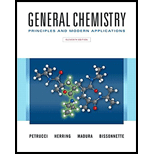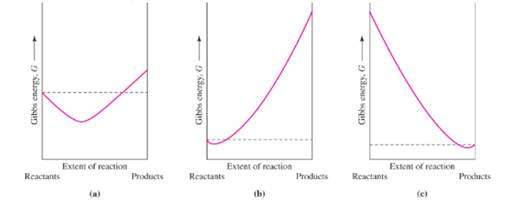
GENERAL CHEMISTRY(LL)-W/MASTERINGCHEM.
11th Edition
ISBN: 9780134566030
Author: Petrucci
Publisher: PEARSON
expand_more
expand_more
format_list_bulleted
Textbook Question
Chapter 13, Problem 118SAE
At room temperature and normal atmospheric pressure, is the entropy change of the universe positive, negative, or zero for the transition of carbon dioxide solid to liquid?

Expert Solution & Answer
Want to see the full answer?
Check out a sample textbook solution
Students have asked these similar questions
please solve this problem by telling me which boxes to check. Thank you in advance!
Explain what characteristics of metalloids are more like metals and which are more like nonmetals, based on Na, Mg, Fe, Cl, and Ar.
please solve this, and help me know which boxes to check. Thank you so much in advance.
Chapter 13 Solutions
GENERAL CHEMISTRY(LL)-W/MASTERINGCHEM.
Ch. 13 - Prob. 1ECh. 13 - Consider a sample of ideal gas initially in a...Ch. 13 - Prob. 3ECh. 13 - Prob. 4ECh. 13 - Indicate whether each of the following changes...Ch. 13 - Arrange the entropy changes of the following...Ch. 13 - Prob. 7ECh. 13 - Prob. 8ECh. 13 - Indicate whether entropy increases or decreases in...Ch. 13 - Which substance in each of the following pairs...
Ch. 13 - Without performing any calculations or using data...Ch. 13 - By analogy to tH and tG how would you would you...Ch. 13 - Calculate the entropy change, S , for the...Ch. 13 - Calculate the entropy change, S , for the...Ch. 13 - IN Example 13-3, we dealt with vipH and vipH for...Ch. 13 - Pentane is one of the most volatile of the...Ch. 13 - Prob. 17ECh. 13 - Estimate the normal boiling point of bromine. Br2,...Ch. 13 - Prob. 19ECh. 13 - Refer to Figure 12-28 and equation (13.13) Which...Ch. 13 - Which of the following changes m a thermodynamic...Ch. 13 - If a reaction can be carried out only because of...Ch. 13 - Indicate which of the four cases in Table 13.3...Ch. 13 - Indicate which of the four cases in Table 13....Ch. 13 - For the mixing of ideal gases (see Figure 13-3),...Ch. 13 - In Chapter 14,, we will see that, for the...Ch. 13 - Explain why (a) some exothermic reactions do not...Ch. 13 - Explain why you would expect a reaction of the...Ch. 13 - From the data given in the following table,...Ch. 13 - Use data from Appendix D to determine values of tG...Ch. 13 - At 298 K, for the reaction...Ch. 13 - At 298 K, for the reaction...Ch. 13 - The following tG values are given for 25C ....Ch. 13 - The following tG values are given for 25C ....Ch. 13 - Write an equation for the combustion of one mole...Ch. 13 - Use molar entropies from Appendix D, together with...Ch. 13 - Assess the feasibility of the reaction...Ch. 13 - Prob. 38ECh. 13 - For each of the following reactions, write down...Ch. 13 - H2(g) can be prepared by passing steam over hot...Ch. 13 - In the synthesis of gasesous methanol from carbon...Ch. 13 - Prob. 42ECh. 13 - Use data from Appendix D to determine K at 298 K...Ch. 13 - Use data from Appendix D to establish for the...Ch. 13 - Use data from Appendix D to determine value at 298...Ch. 13 - Prob. 46ECh. 13 - Use thermodynamic data at 298 K to decide in with...Ch. 13 - Use thermodynamic data at 298 K to decide m which...Ch. 13 - For the reaction below, tG=27.07kJmol1 at 298 K....Ch. 13 - For the reaction below, tG=29.05kJmol1 at 298 K....Ch. 13 - For the reaction 2NO(g)+O2(g)2NO2(g) all but one...Ch. 13 - Prob. 52ECh. 13 - Prob. 53ECh. 13 - For the reaction 2SO2(g)+O2(g)2SO2(g),Kz=2.8102M1...Ch. 13 - Prob. 55ECh. 13 - Prob. 56ECh. 13 - Prob. 57ECh. 13 - Prob. 58ECh. 13 - To establish the law of conservation of mass,...Ch. 13 - Currently, CO2 is being studied as a source of...Ch. 13 - Prob. 61ECh. 13 - A possible reaction for converting methanol to...Ch. 13 - What must be the temperature W the following...Ch. 13 - Prob. 64ECh. 13 - The synthesis of ammonia by the Haber process...Ch. 13 - Use data from Appendix D to determine (a) tH,tS ,...Ch. 13 - Prob. 67ECh. 13 - The blowing equilibrium constants have been...Ch. 13 - For the reaction N 2 O 4 ( g ) 2N O 2 ( g ) , H e...Ch. 13 - Prob. 70ECh. 13 - Prob. 71ECh. 13 - Prob. 72ECh. 13 - Titanium is obtained by the reduction of TiCl4(l)...Ch. 13 - Prob. 74ECh. 13 - Prob. 75ECh. 13 - Prob. 76ECh. 13 - Prob. 77IAECh. 13 - Prob. 78IAECh. 13 - Consider the following hypothetical process in...Ch. 13 - One mole of argon gas, Ar(g), undergoes a change...Ch. 13 - Prob. 81IAECh. 13 - Consider the vaporization of water: H2O(l)H2O(g)...Ch. 13 - Prob. 83IAECh. 13 - Prob. 84IAECh. 13 - The following table shows the enthalpies end Gibbs...Ch. 13 - Prob. 86IAECh. 13 - Prob. 87IAECh. 13 - Prob. 88IAECh. 13 - Prob. 89IAECh. 13 - Prob. 90IAECh. 13 - Prob. 91IAECh. 13 - Prob. 92IAECh. 13 - Prob. 93IAECh. 13 - Prob. 94IAECh. 13 - Prob. 95IAECh. 13 - Use the following data to estimate,...Ch. 13 - Prob. 97IAECh. 13 - Prob. 98IAECh. 13 - Prob. 99IAECh. 13 - Prob. 100FPCh. 13 - The graph shows how shows how tG varies with...Ch. 13 - Prob. 102FPCh. 13 - Prob. 103FPCh. 13 - Prob. 104FPCh. 13 - Prob. 105SAECh. 13 - Briefly describe each of the following ideas,...Ch. 13 - Prob. 107SAECh. 13 - Prob. 108SAECh. 13 - Prob. 109SAECh. 13 - The reaction, 2Cl2O(g)2Cl2(g)+O2(g)tH=161kJ , is...Ch. 13 - Prob. 111SAECh. 13 - Prob. 112SAECh. 13 - Prob. 113SAECh. 13 - Prob. 114SAECh. 13 - Prob. 115SAECh. 13 - Prob. 116SAECh. 13 - Which of the following graphs of Gibbs energy...Ch. 13 - At room temperature and normal atmospheric...
Knowledge Booster
Learn more about
Need a deep-dive on the concept behind this application? Look no further. Learn more about this topic, chemistry and related others by exploring similar questions and additional content below.Similar questions
- Electronegativity is a measure of the tendency of an atom to attract a bonding pair of electrons. Describe how electronegativity is illustrated on the periodic table including trends between groups and periods and significance of atom size.arrow_forwardDefine the term “transition.” How does this definition apply to the transition metals?arrow_forwardDescribe how the properties of the different types of elements (metals, nonmetals, metalloids) differ.arrow_forward
- Use a textbook or other valid source to research the physical and chemical properties of each element listed in Data Table 1 using the following as a guideline: Ductile (able to be deformed without losing toughness) and malleable (able to be hammered or pressed permanently out of shape without breaking or cracking) or not ductile or malleable Good, semi, or poor conductors of electricity and heat High or low melting and boiling points Occur or do not occur uncombined/freely in nature High, intermediate, or low reactivity Loses or gains electrons during reactions or is not reactivearrow_forwardProvide the Physical and Chemical Properties of Elements of the following elements listedarrow_forwardQuestions 4 and 5arrow_forward
- For a titration of 40.00 mL of 0.0500 M oxalic acid H2C2O4 with 0.1000 M KOH, calculate the pH at each of the following volume of KOH used in the titration: 1) before the titration begin;2) 15 mL; 3) 20 mL; 4) 25 mL; 5) 40 mL; 6) 50 mL. Ka1 = 5.90×10^-2, Ka2 = 6.50×10^-5 for oxalic acid.arrow_forwardPredict the major organic product(s), if any, of the following reactions. Assume all reagents are in excess unless otherwise indicated.arrow_forwardPredict the major organic product(s), if any, of the following reactions. Assume all reagents are in excess unless otherwise indicated.arrow_forward
- How many signals would you expect to find in the 1 H NMR spectrum of each given compound? Part 1 of 2 2 Part 2 of 2 HO 5 ☑ Х IIIIII***** §arrow_forwardA carbonyl compound has a molecular ion with a m/z of 86. The mass spectra of this compound also has a base peak with a m/z of 57. Draw the correct structure of this molecule. Drawingarrow_forwardCan you draw this using Lewis dot structures and full structures in the same way they are so that I can better visualize them and then determine resonance?arrow_forward
arrow_back_ios
SEE MORE QUESTIONS
arrow_forward_ios
Recommended textbooks for you
- Chemistry: Matter and ChangeChemistryISBN:9780078746376Author:Dinah Zike, Laurel Dingrando, Nicholas Hainen, Cheryl WistromPublisher:Glencoe/McGraw-Hill School Pub Co
 Chemistry: Principles and PracticeChemistryISBN:9780534420123Author:Daniel L. Reger, Scott R. Goode, David W. Ball, Edward MercerPublisher:Cengage Learning
Chemistry: Principles and PracticeChemistryISBN:9780534420123Author:Daniel L. Reger, Scott R. Goode, David W. Ball, Edward MercerPublisher:Cengage Learning General Chemistry - Standalone book (MindTap Cour...ChemistryISBN:9781305580343Author:Steven D. Gammon, Ebbing, Darrell Ebbing, Steven D., Darrell; Gammon, Darrell Ebbing; Steven D. Gammon, Darrell D.; Gammon, Ebbing; Steven D. Gammon; DarrellPublisher:Cengage Learning
General Chemistry - Standalone book (MindTap Cour...ChemistryISBN:9781305580343Author:Steven D. Gammon, Ebbing, Darrell Ebbing, Steven D., Darrell; Gammon, Darrell Ebbing; Steven D. Gammon, Darrell D.; Gammon, Ebbing; Steven D. Gammon; DarrellPublisher:Cengage Learning  Chemistry: The Molecular ScienceChemistryISBN:9781285199047Author:John W. Moore, Conrad L. StanitskiPublisher:Cengage Learning
Chemistry: The Molecular ScienceChemistryISBN:9781285199047Author:John W. Moore, Conrad L. StanitskiPublisher:Cengage Learning Physical ChemistryChemistryISBN:9781133958437Author:Ball, David W. (david Warren), BAER, TomasPublisher:Wadsworth Cengage Learning,
Physical ChemistryChemistryISBN:9781133958437Author:Ball, David W. (david Warren), BAER, TomasPublisher:Wadsworth Cengage Learning, Principles of Modern ChemistryChemistryISBN:9781305079113Author:David W. Oxtoby, H. Pat Gillis, Laurie J. ButlerPublisher:Cengage Learning
Principles of Modern ChemistryChemistryISBN:9781305079113Author:David W. Oxtoby, H. Pat Gillis, Laurie J. ButlerPublisher:Cengage Learning

Chemistry: Matter and Change
Chemistry
ISBN:9780078746376
Author:Dinah Zike, Laurel Dingrando, Nicholas Hainen, Cheryl Wistrom
Publisher:Glencoe/McGraw-Hill School Pub Co

Chemistry: Principles and Practice
Chemistry
ISBN:9780534420123
Author:Daniel L. Reger, Scott R. Goode, David W. Ball, Edward Mercer
Publisher:Cengage Learning

General Chemistry - Standalone book (MindTap Cour...
Chemistry
ISBN:9781305580343
Author:Steven D. Gammon, Ebbing, Darrell Ebbing, Steven D., Darrell; Gammon, Darrell Ebbing; Steven D. Gammon, Darrell D.; Gammon, Ebbing; Steven D. Gammon; Darrell
Publisher:Cengage Learning

Chemistry: The Molecular Science
Chemistry
ISBN:9781285199047
Author:John W. Moore, Conrad L. Stanitski
Publisher:Cengage Learning

Physical Chemistry
Chemistry
ISBN:9781133958437
Author:Ball, David W. (david Warren), BAER, Tomas
Publisher:Wadsworth Cengage Learning,

Principles of Modern Chemistry
Chemistry
ISBN:9781305079113
Author:David W. Oxtoby, H. Pat Gillis, Laurie J. Butler
Publisher:Cengage Learning
The Laws of Thermodynamics, Entropy, and Gibbs Free Energy; Author: Professor Dave Explains;https://www.youtube.com/watch?v=8N1BxHgsoOw;License: Standard YouTube License, CC-BY